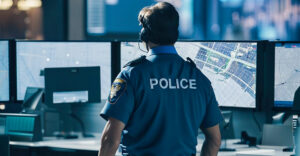
Half a year after its first rollout of a passenger imaging security scanner in the Phoenix airport, the Transportation Security Administration is testing another form of this technology there.
Its latest security machine is based on millimeter-wave technology, which is similar in function to the X-ray backscatter technology TSA began testing in February.
While the technologies are different — the backscatter uses non-penetrating X-rays and the millimeter uses electromagnetic waves — the end result for travelers is the same: Both machines produce a clear image of the body, allowing guards to scan for weapons or other forms of contraband.
Naked Pictures
The privacy implications are immense, although TSA is quick to point to the safeguards it has in place to ensure that the technology is not abused. Privacy advocates at Electronic Privacy Information Center are unimpressed with TSA’s promises, however, and are calling for a law forbidding the storage or transmittal of these images.
“We are not against the scanning technology per se,” Marc Rotenberg, EPIC’s executive director, told TechNewsWorld. “However, a law needs to codify the rights of passengers with this technology.”
EPIC has raised this point with the Homeland Security committees in both the House and the Senate, Rotenberg said. “Such a measure could be tacked onto the next appropriate bill.”
Without a legal backstop, he added, “this will become a giant system to collect and store naked pictures of American travelers.”
Multiple Safeguards
The safeguards TSA has in place would make such a development impossible, according to spokesperson Amy Kudwa.
“First, there is a remote viewing location so the security officer viewing the image of the passenger cannot connect the image to the actual person,” she told TechNewsWorld. “Also, the security officer at the screening — the one with the passenger — does not see the image. If the security officer in the imaging room thinks a passenger needs to be searched, he or she communicates with the other officer via wireless communication.”
There is a privacy algorithm used with the backscatter technology that, when applied to the image, renders it similar to a cartoon or chalk outline. With the newly introduced millimeter wave technology the raw image is very fuzzy and the face is blurred.
Does It Store?
The machines “have zero storage capability, so the images cannot be stored, transmitted or printed. Once the image is determined to be clear of any threat, it is deleted from the screen forever,” Kudwa added.
“TSA saying these machines cannot store images is a little like saying a camera can produce pictures without storing an image,” Rotenberg said. “We know from the [Web site of] one of the vendors that these machines can indeed store images.”
Rapiscan, L-3 Communication and AS&E are the three main vendors of this technology.
Rotenberg understands TSA is trying to assure people that the image will not be saved or stored, “but that has to be backed up with a change in the law.”
Promises and public statements by TSA are not legally binding, he noted.
“Essentially, these machines are digital cameras,” he said.
Digital Imaging vs. the Patdown
This is a finer point lost on many travelers, Rotenberg said, but is even more crucial to privacy protection than the separate security officers manning the technology.
Travelers though, at least those going through Phoenix, don’t appear to be concerned. Indeed, when offered the choice of digital imaging or a patdown search, they overwhelmingly opted for the scan, according to Kudwa.
Since it introduced the backscatter technology in February, it found that 79 percent of travelers opted for the scan when secondary screening is necessary.




















































